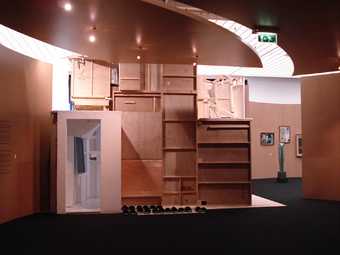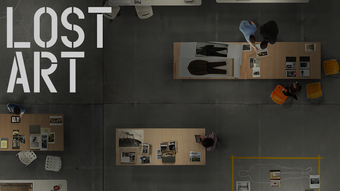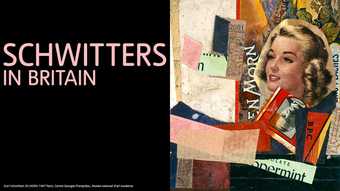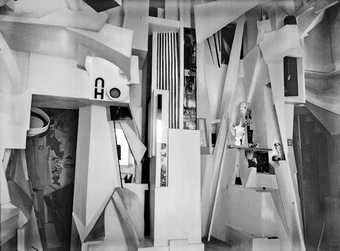
Fig.1
Kurt Schwitters
Merzbau
Photo: Wilhelm Redemann, 1933 © DACS 2007
One of the most important art works and myths in modern art, the inspiration for many installation artists, and still one of the most well known and published works by Kurt Schwitters (1887–1948), the Merzbau, in fact, no longer exists. It was destroyed in a British air raid in October 1943 in Hannover. By 1937, when Schwitters left his hometown to follow his son into exile in Oslo, the Merzbau comprised a total of eight rooms in his house at 5 Waldhausenstraße in Hannover. Most of the surviving photographs seem to have been taken in the space of the ‘Merzbau proper’ (‘eigentlicher Merzbau’), in which Schwitters is known to have begun working at the beginning of 1927. Three photographs taken by Wilhelm Redemann in 1933 show the most detailed and complete overview of this main room.
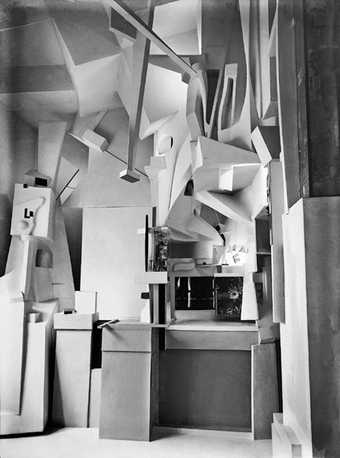
Fig.2
Kurt Schwitters
Merzbau
Photo: Wilhelm Redemann, 1933 © DACS 2007
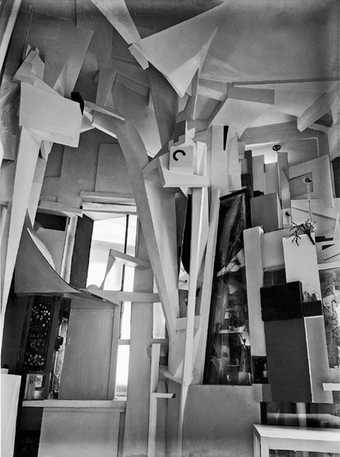
Fig.3
Kurt Schwitters
Merzbau
Photo: Wilhelm Redemann, 1933 © DACS 2007
Based on these photographs, the Switch stage designer Peter Bissegger executed a reconstruction of the ‘Merzbau proper’ between 1981 and 1983, assisted and supported by the artist’s son Ernst Schwitters. Harald Szeemann commissioned Bissegger to make a one-to-one reconstruction and it formed part of his famous exhibition Der Hang zum Gesamtkunstwerk, which included other reconstructions of this kind. Szeemann called it an ‘attempt at reconstruction’. He was himself aware of the inherent problems of making a reconstruction of a work that is in its very core an unfinished permanent work in progress, intended to grow and spread from ‘Hannover to Berlin’. Indeed, Schwitters’ aim can be surmised by the fact that he started his Merzbau again and again at the different locations where he lived (Hannover, Kijkduin, Lysaker, Hjertøya, Douglas, Elterwater), carrying it around him like a snail-shell.
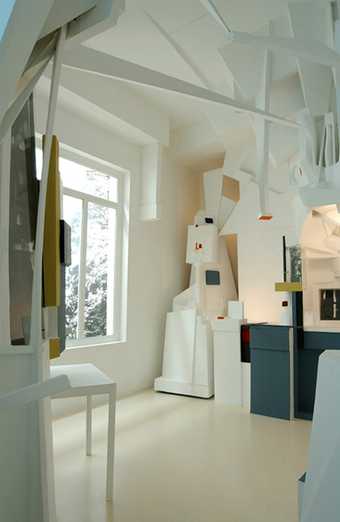
Fig.4
Kurt Schwitters
Merzbau 1933, reconstruction by Peter Bissegger 1981–3
393 x 580 x 460 cm
Sprengel Museum Hannover © DACS 2007
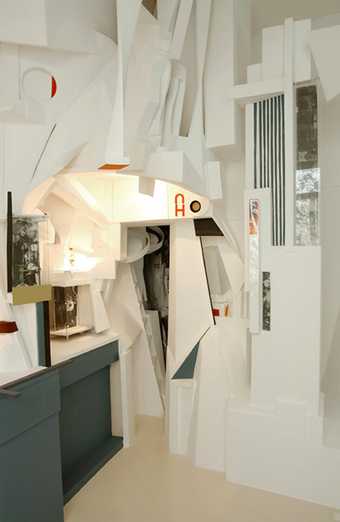
Fig.5
Kurt Schwitters
Merzbau 1933, reconstruction by Peter Bissegger 1981–3
Sprengel Museum Hannover © DACS 2007
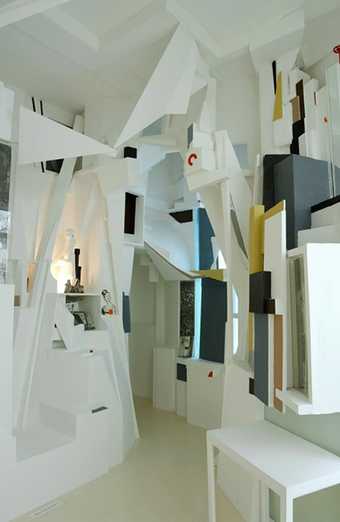
Fig.6
Kurt Schwitters
Merzbau 1933, reconstruction by Peter Bissegger 1981–3
393 x 580 x 460 cm
Sprengel Museum Hannover © DACS 2007
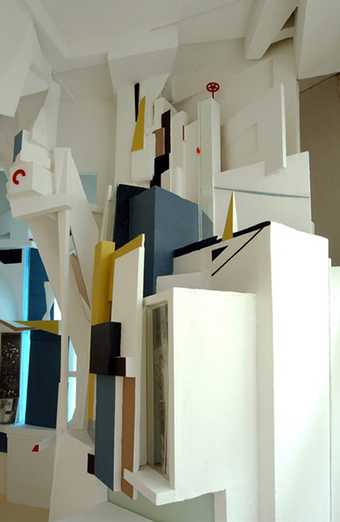
Fig.7
Kurt Schwitters
Merzbau 1933, reconstruction by Peter Bissegger 1981–3
393 x 580 x 460 cm
Sprengel Museum Hannover © DACS 2007
Bissegger’s task was a very difficult one: he did not have the exact measurements or scale of the room and had to work by complicated geometric calculations based on the only hard evidence, the photographs, some vague floor plans of the flat as well as on the recollection of the artist’s son, who had seen the room forty-four years previously when he was eighteen years old. Bissegger managed to find out what kind of camera lens and focal length (14.1 cm, Protar wide-angle camera) were used. Fortunately, there was one point that appeared on all three photographs which enabled him to calculate the three-dimensional model.
Another issue was that the contents of the ‘grottos’ were not reproducible. Instead, enlargements of the historic photographs were used. The different methods of lighting installed by Schwitters, as well as their colours, were installed according to the recollection of Ernst Schwitters.
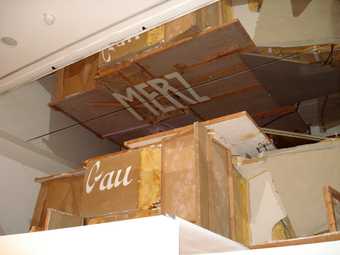
Fig.8
Kurt Schwitters
Merzbau 1933, reconstruction by Peter Bissegger 1981–3
Present installation at the Sprengel Museum Hannover
and detail of a ‘grotto’
Sprengel Museum Hannover © DACS 2007
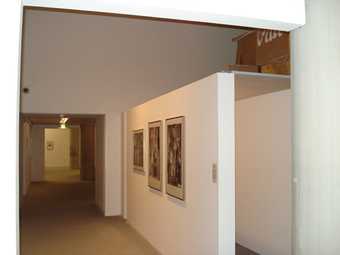
Fig.9
Kurt Schwitters
Merzbau 1933, reconstruction by Peter Bissegger 1981–3
Present installation at the Sprengel Museum Hannover
and detail of a ‘grotto’
Sprengel Museum Hannover © DACS 2007
After the exhibition tour the reconstruction was bought and permanently installed in the Sprengel Museum Hannover. In this present installation, which was also made by Bissegger, it is our view that the public consider the outside ceiling of the reconstruction with the word ‘Merzbau’ and the mirror at the ceiling to have been made by Schwitters. Although it is labelled in an appropriate way, they often do not realise that this is a reconstruction and not an original work of art. After many discussions with Bissegger who owns the copyright on the reconstruction, we are about to change this situation and cover the complete exterior with a wall, and install more extensive explanations and contextual information.

Fig.10
Kurt Schwitters
Merzbau 1933, reconstruction by Peter Bissegger 1981–3
Present installation at the Sprengel Museum Hannover
and detail of a ‘grotto’
Sprengel Museum Hannover © DACS 2007
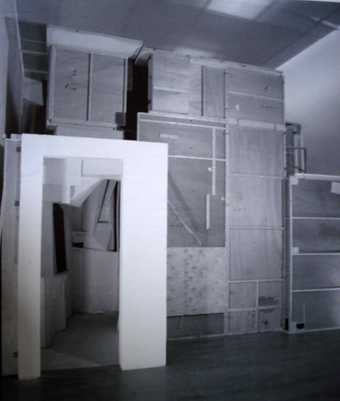
Fig.11
Merzbau, travelling version 1988
Reconstruction in PAC, Milan 2001
© DACS 2007
For the exhibition Dada and Constructivism 1988–9 at Annely Juda Fine Art, London, a second, practical ‘travel copy’ of the Merzbau was made under Bissegger’s direction. Since then this travelling version has been mounted and dismounted twenty-three times all over the world. Currently, it is on view in the Pinacoteca in São Paulo. If the spatial circumstances allow it, the Merzbau is often presented without covering walls. Bissegger argues that this kind of presentation makes it obvious that it is a reconstructed model, not to be confused with the original work. But ultimately, it does risk the danger of being mistaken for a contemporary installation work or the original work by Schwitters.

